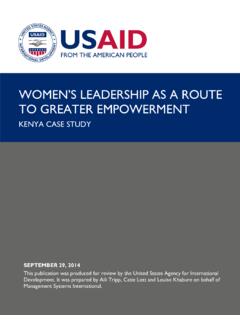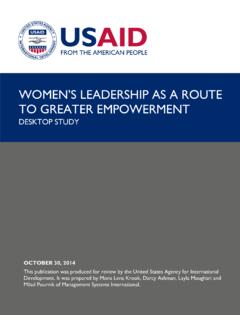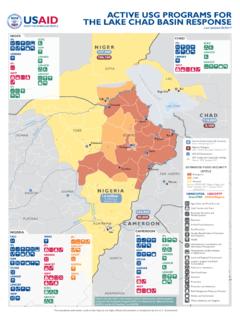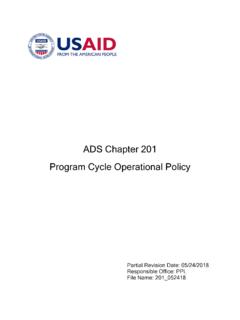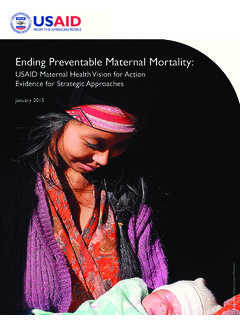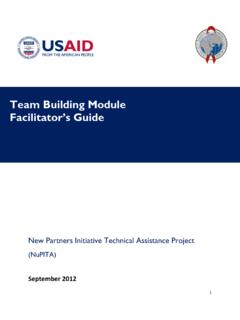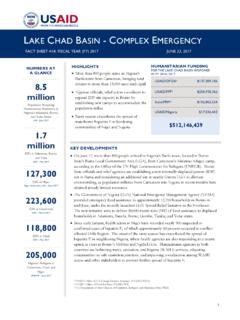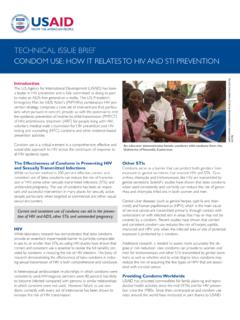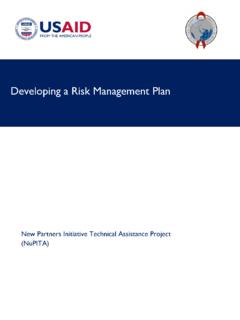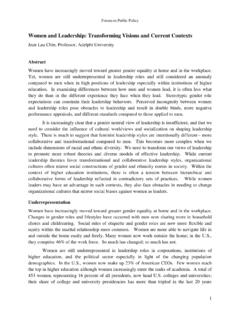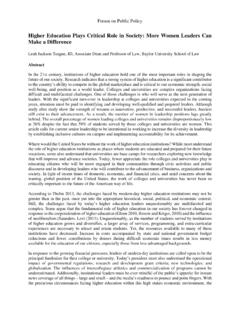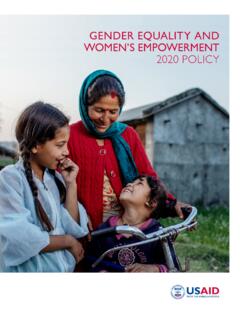Transcription of WOMEN & CONFLICT
1 WOMEN & CONFLICT , 2007AN INTRODUCTORY GUIDE FOR PROGRAMMINGWOMEN & CONFLICTKey IssuesLessons LearnedProgram OptionsResources 2 WOMEN & CONFLICT , 2007 CONFLICT arises due to a complex set of variables coming together and reinforcing each other at multiple levels and at critical junctures of a country or region s development. It leaves in its af-termath significant development and humanitarian challenges. USAID recognizes that CONFLICT is an inherent and legitimate part of social and political life, and is often a precursor to positive the consequences of CONFLICT can also be alarmingly high. Therefore, USAID has adopted a new policy by which it will aggressively expand its development and implementation of programs mitigating the causes and consequences of CONFLICT , instability, fragility and extremism.
2 Since develop-ment and humanitarian assistance programs are increasingly implemented in situations of open or latent violence, USAID must explicitly incorporate sensi-tivity to the dynamics of CONFLICT and instability in their design or Office of CONFLICT Management and Mitigation in the Bureau for Democracy, CONFLICT , and Humanitarian Assistance (DCHA/CMM) of the United States Agency for International Develop-ment (USAID) was established to provide technical leadership on CONFLICT , instability, extrem-ism and now terrorism and insurgency to Missions and our Washington vast majority of our field missions and staff are currently working in areas that are either in CONFLICT , coming out of CONFLICT , are at high-risk for violence and instability, or are facing growing extrem-ist threats.
3 A central objective of the office is to integrate or mainstream best practices in CONFLICT management and mitigation into more traditional development sectors such as agricul-ture, economic growth, democracy, education, and health. Increasingly, DCHA/CMM is also working with missions to help them understand how to work in countries experiencing growing fragility, instability and in some cases insurgencies. Where appropriate, DCHA/CMM will be an advocate for stable Director of DCHA/CMM, I am pleased to introduce this document on WOMEN and CONFLICT . This guide identifies the key issues and methods for understanding the common impact of CONFLICT on WOMEN and some of the creative ways that USAID can respond to address the most vital needs of those affected by Kvitashvili DirectorOffice of CONFLICT Management and MitigationBureau for Democracy, CONFLICT and Humanitarian Agency for International Development (USAID) FROM THE DIRECTOR WOMEN & CONFLICT , 2007women and CONFLICT : an introductory guide to programmingWhile CONFLICT inflicts suffering on everyone, WOMEN are particularly affected by its short- and long-term effects.
4 Sexual assault and exploitation are frequently employed as tools of war; victimization leads to isolation, alienation, prolonged emotional trauma, and unwanted pregnancies that often result in abandoned children. As culturally-designated caregivers, WOMEN must struggle to support their families and keep their households together while the traditional bread-winners husbands and sons are caught up in the fighting and are unable to provide for their families. The new role as primary provider exposes many WOMEN to further abuse. CONFLICT shatters the comfort of predictable daily routines and expectations. WOMEN and girls are equally affected in a fragile environment where social services they once depended on degrade or disappear.
5 Although CONFLICT may, in some cases, improve gender relations as a result of shifts in gender roles - some changes even improve WOMEN s rights - by and large its impact on WOMEN is devastatingly negative. WOMEN are rarely mere passive victims of CONFLICT and should not be treated as such. WOMEN can play active roles in the events that lead to fighting and instability, and even in combat itself - yet they have also served as the forerunners of peace movements that have ended CONFLICT . However, the determined efforts of WOMEN to bring an end to fighting is usually behind the introductory guide describes the ways in which CONFLICT and fragility may increase gender inequities and suggests programming approaches that address these issues while building on the strengths of WOMEN .
6 With this guide, DCHA/CMM aims to both raise awareness among USAID Mission employees of issues surrounding WOMEN and CONFLICT , and to assist USAID by integrating CONFLICT and gender project coordinators and the authors wish to thank Judy Benjamin for her early work on this guide, which has benefited from substantial discussions with Sahana Dharmapuri of the Office of WOMEN in Development in the Bureau for Economic Growth, Agriculture, and Trade at USAID, and Brenda Opperman, former Gender Advisor for USAID/Iraq, and from dialogues with development partners such as Inclusive Security: WOMEN Waging Peace. This document follows their lead in shaping a guide with suggestions for USAID Mission ISSUES LESSOnS LEArnED PrOGrAM OPTIOnS rESOUrCES 72 2 defining WOMEN in conflictThis guide focuses on the particular roles, needs, and vulnerabilities of WOMEN in CONFLICT settings so that the most appropriate interventions can be determined and initiated.
7 The term WOMEN is purposefully used because the focus is on their role in environments of instability, fragility, and CONFLICT , rather than on broader gender issues. Gender is used where appropriate to refer to social and cultural issues relating to female-male interactions and roles. By focusing on the roles and lives of WOMEN , the guide acknowledges that interventions are more effective and lasting when they integrate an understanding of WOMEN s perspectives, while at the same time fostering awareness that crises of fragility and CONFLICT can challenge and alter gender roles - often radically and and development issues may overlap or be identical to those relating to WOMEN and CONFLICT .
8 Many of the key issues and best practices identified in these pages will in fact be the same as those that are useful in general development settings and/or in humanitarian/emergency responses. However, the focus here is on WOMEN s roles in CONFLICT situations, and the best practices for addressing them. Although WOMEN s roles vary in every CONFLICT , they generally fall into the following categories: Agents of change Active participants (combatants) Supporting participants or shields (forced or voluntary camp followers, cooks, wives, slaves, etc.) Victims and spoils of war newly responsible care providersThese roles will be addressed throughout the guide and programmatic options will be provided accordingly.
9 New programs are not always necessary; these options may simply be incorporated into existing programs. However, this is not always the case and opportunities to address the role of WOMEN in CONFLICT can be lost if the surrounding issues are not acknowledged and understood. WOMEN & CONFLICT , 2007cultural context & SenSitivity - StatuS & role of WOMEN in SocietyWhile the United nations and many in the international community recognize equal rights and status for WOMEN as a legitimate goal to pursue globally, the speed and manner in which this goal can be attained will vary according to the cultural setting. Just as each country has its own unique culture and traditions, each society views the role of WOMEN differently.
10 This will vary by country/region and can be influenced by such factors as education, religious and cultural norms, the legal status of WOMEN , and the degree of exposure to Western ideas and culture. Program options will therefore need to be adapted to particular settings, even in emergency and humanitarian the culture and currently prescribed role of WOMEN in a society is absolutely necessary when working on gender-specific programs. This remains true during CONFLICT and in its aftermath. WOMEN s role and status in society will determine best practices and the appropriate means of intervention in order to empower rather than endanger WOMEN . While in some cases WOMEN s position in society is relatively strong, in other cases religion, tradition, legal status or other issues may present substantial obstacles to program aS agentS of change and peacemakerSWomen must be involved in CONFLICT prevention, resolution and management efforts at all levels.
